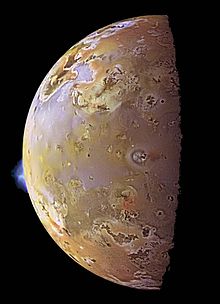
Back براكين آيو Arabic Вулканізм на Іо Byelorussian আইয়োতে অগ্ন্যুৎপাত Bengali/Bangla Vulcanisme a Io Catalan Vulkanismus na Io Czech Vulkanismus auf dem Jupitermond Io German Vulcanismo en Ío Spanish Ioko bolkanismoa Basque Volcanisme sur Io French Vulcanismo su Io Italian

Volcanism on Io, a moon of Jupiter, is represented by the presence of volcanoes, volcanic pits and lava flows on the surface. Io's volcanic activity was discovered in 1979 by Linda Morabito, an imaging scientist working on Voyager 1.[1] Observations of Io by passing spacecraft and Earth-based astronomers have revealed more than 150 active volcanoes. As of 2004[update], up to 400 such volcanoes are predicted to exist based on these observations.[2][outdated statistic] Io's volcanism makes the satellite one of only four known currently volcanically or cryovolcanically active worlds in the Solar System (the others being Earth, Saturn's moon Enceladus, and Neptune's moon Triton.)
First predicted shortly before the Voyager 1 flyby, the heat source for Io's volcanism comes from tidal heating produced by its forced orbital eccentricity.[3] This differs from Earth's internal heating, which is derived primarily from radioactive isotope decay and primordial heat of accretion.[4] Io's eccentric orbit leads to a slight difference in Jupiter's gravitational pull on the satellite between its closest and farthest points on its orbit, causing a varying tidal bulge. This variation in the shape of Io causes frictional heating in its interior. Without this tidal heating, Io might have been similar to the Moon, a world of similar size and mass, geologically dead and covered with numerous impact craters.[3]
Io's volcanism has led to the formation of hundreds of volcanic centres and extensive lava formations, making it the most volcanically active body in the Solar System. Three different types of volcanic eruptions have been identified, differing in duration, intensity, lava effusion rate, and whether the eruption occurs within a volcanic pit (known as a patera). Lava flows on Io, tens or hundreds of kilometres long, have primarily basaltic composition, similar to lavas seen on Earth at shield volcanoes such as Kīlauea in Hawaii.[5] Although most of the lava on Io is made of basalt, a few lava flows consisting of sulfur and sulfur dioxide have been seen. In addition, eruption temperatures as high as 1,600 K (1,300 °C; 2,400 °F) were detected, which can be explained by the eruption of high-temperature ultramafic silicate lavas.[6]
As a result of the presence of significant quantities of sulfurous materials in Io's crust and on its surface, some eruptions propel sulfur, sulfur dioxide gas, and pyroclastic material up to 500 kilometres (310 mi) into space, producing large, umbrella-shaped volcanic plumes.[7] This material paints the surrounding terrain in red, black, and/or white, and provides material for Io's patchy atmosphere and Jupiter's extensive magnetosphere. Spacecraft that have flown by Io since 1979 have observed numerous surface changes as a result of Io's volcanic activity.[8]
Further observations by the Juno orbiter of volcanism and volcanic plumes on Io were made during a 3 February 2024 flyby.[9]
- ^ Morabito, L. A.; et al. (1979). "Discovery of currently active extraterrestrial volcanism". Science. 204 (4396): 972. Bibcode:1979Sci...204..972M. doi:10.1126/science.204.4396.972.a. PMID 17800432. S2CID 45693338.
- ^ Lopes, R. M. C.; et al. (2004). "Lava lakes on Io: Observations of Io's volcanic activity from Galileo NIMS during the 2001 fly-bys". Icarus. 169 (1): 140–74. Bibcode:2004Icar..169..140L. doi:10.1016/j.icarus.2003.11.013.
- ^ a b Peale, S. J.; et al. (1979). "Melting of Io by Tidal Dissipation". Science. 203 (4383): 892–94. Bibcode:1979Sci...203..892P. doi:10.1126/science.203.4383.892. PMID 17771724. S2CID 21271617.
- ^ Watson, J. M. (May 5, 1999). "Some Unanswered Questions". United States Geological Survey. Retrieved October 11, 2008.
- ^ Keszthelyi, L.; et al. (2007). "New estimates for Io eruption temperatures: Implications for the interior". Icarus. 192 (2): 491–502. Bibcode:2007Icar..192..491K. doi:10.1016/j.icarus.2007.07.008.
- ^ Williams, D. A.; Howell, R. R. (2007). "Active volcanism: Effusive eruptions". In Lopes, R. M. C.; Spencer, J. R. (eds.). Io after Galileo. Springer-Praxis. pp. 133–61. ISBN 978-3-540-34681-4.
- ^ Geissler, P. E.; McMillan, M. T. (2008). "Galileo observations of volcanic plumes on Io". Icarus. 197 (2): 505–18. Bibcode:2008Icar..197..505G. doi:10.1016/j.icarus.2008.05.005.
- ^ Geissler, P.; et al. (2004). "Surface changes on Io during the Galileo mission". Icarus. 169 (1): 29–64. Bibcode:2004Icar..169...29G. doi:10.1016/j.icarus.2003.09.024.
- ^ Miller, Katrina (February 6, 2024). "NASA Spots Signs of Twin Volcanic Plumes on Jupiter's Moon Io - The second of a pair of close flybys adds to the treasure trove of data that scientists have about Jupiter's volcanic moon". The New York Times. Archived from the original on February 7, 2024. Retrieved February 7, 2024.
© MMXXIII Rich X Search. We shall prevail. All rights reserved. Rich X Search